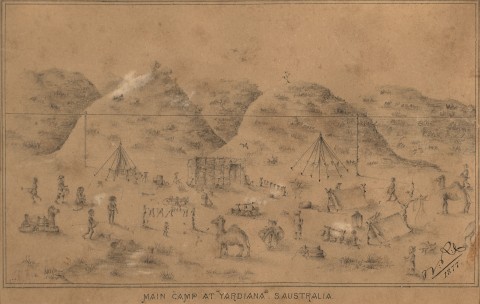MAIN CAMP AT “YARDIANA”, SOUTH AUSTRALIA, 1877
ARTIST UNKNOWN
pencil and chalk on paper
11.0 x 18.0 cm
signed with initials and dated lower right: WR… / 1877
bears inscription below image: MAIN CAMP AT “YARDIANA”. S. AUSTRALIA
Private collection
Sotheby's, Melbourne, 6 April 1987, lot 15
Private collection, Melbourne
The subject appears to depict the site for the construction of the East – West Telegraph Line extension between Adelaide and Western Australia at Yardea, 143 miles west of Port Augusta.
Deriving from the aboriginal word “Yardianna” as used in the title, meaning ‘place of rushes’, Yardea Station was established on the traditional lands of the Kokatha, Wirangu and Barngarla peoples prior to 1865, and featured a freshwater spring. This was the first property taken up in the Gawler Ranges.
Equipment and materials for the telegraph line were brought in by ‘Afghan’ contractors and by mid 1876 the construction had past Yardea and was approaching Eucla on the Western Australia coast border. Eucla Telegraph Station, the largest station on the East-West Telegraph line, opened December 1877 with the first telegraphic message crossing the Nullarbor at 4pm on the 8 December.
‘Elder & Co. brought the first ‘Afghans’ to South Australia to work at Beltana station, north of Port Augusta in the Far North. Thirty-one Afghans arrived on the Blackwell at Port Augusta, and on New Year’s Eve 1865 a crowd gathered to witness the extraordinary sight of 124 camels being lifted onto new soil. Although known as Afghans, the cameleers were in fact Pathans from the border of present-day Afghanistan and Pakistan. Generally from poor backgrounds, they came as single men on three-year contracts. There were some 800 Afghan males in Australia by the 1890s.’1
1. Edwards, J., ‘Afghans’, SA History Hub, History Trust of South Australia, Adelaide, https://sahistoryhub.history.sa.gov.au/subjects/afghans, [accessed 7 July 2023]


